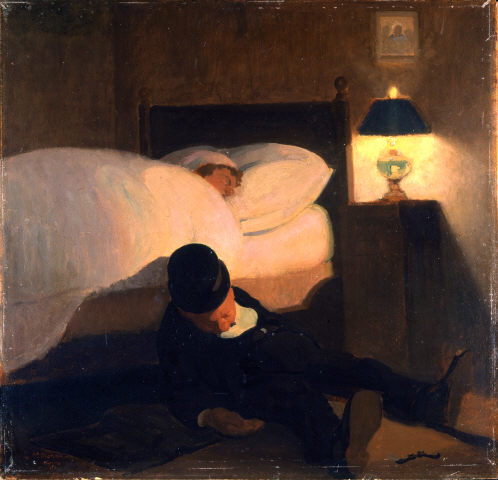
- 1913
- Carton
- Oil
- Inv. 84P48
Emmerico Nunes
Untitled
By depicting this humorous scene on canvas, Emmerico Hartwich Nunes signalled that, for him, caricature and painting were equally noble arts. In Europe, the use of daily life and humble domestic interiors as pictorial subject matter, like the humorous treatment of the same, stem from the Flemish painting tradition of the sixteenth and seventeenth centuries. Throughout the nineteenth century, naturalists and impressionists would return to these themes, this time inspired by Japanese prints, then much in vogue, particularly in Paris. It is precisely to this encounter of genres and different cultural and temporal spaces that Emmerico’s nocturnal scene belongs, a result of his study in the French capital (1906-1911). There he trained in Fine Art, attended the Free Academies and spent much of his spare time copying the old masters: “This week I am going to start a new copy of Rembrandt in the Louvre. I am going to show the last painted study I did to Cormon next week.” (postcard to his father, 28/03/1909).
In Paris he (undoubtedly) collected Japanese prints and then, in 1910, travelled to England, Holland and Belgium, with Manuel Bentes and Eduardo Viana. These various experiences are expressed in the classical composition of the second plane of the canvas, in the treatment of the background, in the chiaroscuro play of light. They are present, too, in the patch of black which envelops the man sleeping on the floor – echoing the blacks of Frans Hals and Francisco Goya, revisited by Edouard Manet. Consider also the sprawling shadow thrown by the male figure (so different from the shadow made by the bedside table), which becomes autonomous from the figure – itself transformed into a pictorial mass – and takes us back to the realm of the print which, inspired by the Japanese tradition, was reinvented in Europe in the second half of the nineteenth century. A strange peace reigns over this nocturnal scene painted by the artist in 1913, two years after his arrival in Munich. The atmosphere of calm well-being that emanates from this German interior, emphasised by the ochre, orange and pink tones of the light that bathes the room and reveals to us the softness of the typical feather eiderdowns, indicates how much Emmerico identified with his mother’s homeland, where he would stay until the outbreak of the First World War.
Isabel Lopes Cardoso
January 2011
| Type | Value | Unit | Section |
| Height | 50 | cm | |
| Width | 52 | cm |
| Type | signature and date |
| Type | Donation |
| Heimo Zobernig e a Colecção do Centro de Arte Moderna da Fundação Calouste Gulbenkian/ Heimo Zobernig and the Collection of the Calouste Gulbenkian Foundation Modern Art Centre; Heimo Zobernig and the Tate Colllection/ Heimo Zobernig e a Colecção da Tate |
| Lisbon, CAM/FCG/ Tate St. Ives, St. Ives, 2009 |
| ISBN:978-1-85437-826-2 |
| Exhibition catalogue |
| Emmerico Hartwich Nunes. Retrato Sensível. Arte e Desenho Humorístico na Imprensa Alemã |
| Museu Nogueira da Silva |
| Curator: Isabel Lopes Cardoso |
| 17 December 2004 to 26 February 2005 Museu Nogueira da Silva, Minho |
| Heimo Zobernig e a Colecção do Centro de Arte Moderna da Fundação Calouste Gulbenkian |
| CAM/FCG |
| Curator: Jürgen Bock |
11 February to 31 Ausgust 2009 Centro de Arte Moderna |
| Exposição Permanente do CAM |
| CAM/FCG |
| Curator: Jorge Molder |
| 18 July 2008 to 4 January 2009 Centro de Arte Moderna |